
..........................................................................................................................................................................................................
specialized turbo vado 2.0 electric bike
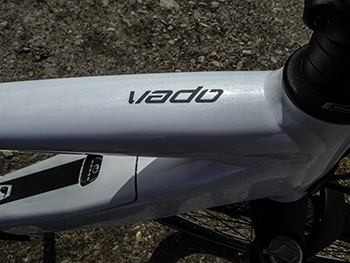
i have long thought that the electric bicycle, or e-bike was marketed to the wrong audience. pretty much all the cyclists i know use cycling either as a means of getting or keeping fit, or for more pro-active sporting endeavours. the notion that their velocipedes be augmented with a smidgeon of electrical power would rather undermine the inherent joy of the bicycle. advertising the e-bike to such an audience would surely be to miss the point?
better, it would appear, to aim all that copywriting at the moped market, those who look upon the bicycle as simply an alternative - albeit economic - means of commuting. aside from one or two drop-bar aberrations, that appears to be the more current thinking and probably not before time.
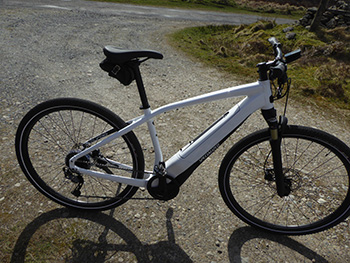
nonetheless, i feel it's worth my pointing out that i do not consider myself in any way the sort of cyclist who might be thought of as an e-bike customer. however, in the interests of proving that assertion, even if only to myself, i was more than happy to accept an offer from the specialized bicycle company to conduct a review of their turbo vado e-bike. the model under consideration sits comfortably at the bottom of the specialized urban range web page, priced at £2,600 and available in both gents' and ladies' versions.

like many e-bikes, the turbo vado employs the pedal-assist means of propulsion; to be ridiculously obvious, unless you actually pedal, the bike remains stationary. and unlike other models with which i have had brief dalliance, there is no 'throttle' that will enable the bike to travel independently of pedalling input.
unlike regular bicycles, an electric bicycle has arguably less need to proffer metallic or carbon resilience, the sort of spring in its step that excites the pedalling aficionado. because in an electrically powered bicycle, the principal impetus of movement arrives via the electric motor concealed (or otherwise) about its person. a previous experience of an electrically powered bicycle was on a faux mountain bike in which the motor was fitted to the rear wheel. the specialized turbo vado, more sensibly in my view, houses the 250w, belt-drive motor in what we once referred to as the bottom bracket. there, it is strategically placed not only to provide a sturdy centre of gravity, but also to provide the pedal assist that ensures the rider has to shoulder at least some of the effort.

classified under the heading of urban e-bikes the vado's substantial frame is basically constructed from aluminium, though it features a healthy dollop of plastic within that colossal downtube (the word seems barely adequate) where the battery sits in silence. the top tube is heavily sloped towards the seatstays, joining each other at the top of a seat tube which kinks as it disappears inside the enormous bottom bracket region. those seatstays effectvely curve back towards the aforementioned bottom bracket, becoming chainstays in the process.
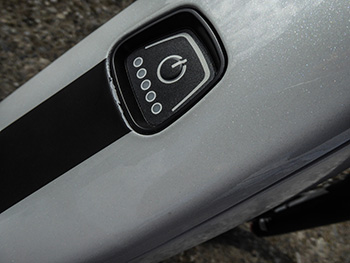
the battery is built to slot (almost) seamlessly into its pre-ordained slot on the left side of the downtube, a construct the girth of which is cleverly diminished by a black-painted lower portion. in direct contrast to virtually every other bicycle in the wide specialized range, the manufacturer's name, often writ large, almost looks like an afterthought on the vado. built into the side of the tube is a key-operated lock designed to release the battery from the frame's grip, just ahead of the charging socket. the battery can be charged in situ, or when removed from the bicycle.
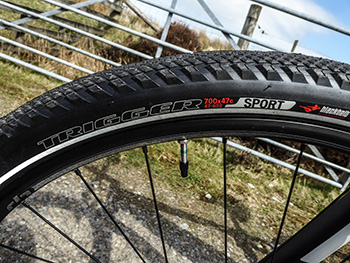
there's a single chainring crank, married to a nine-speed shimano alivio rear dérailleur and 11-36 cassette. changing is managed by a rapid-fire, bar-mounted, right-hand alivio nine-speed gear changer. those gears help power a fairly substantially sized pair of thru-axle wheels, shod with trigger sport, 700 x47mm tyres. stopping is via a pair of tektro hydraulic disc brakes, with specialized's customary larger rotor (180mm) up front reducing to 160mm at the rear. the short stem grasps a 68cm wide handlebar, featuring a 15mm rise and swept back towards the rider. just a tad. the steel-railed specialized canopy sport saddle sits atop a black alloy two-bolt 31.8mm seatpost.
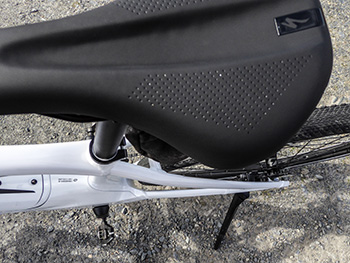
the steel-steerer, front suspension fork is made by suntour, offering up to 50mm of travel and with a lockout dial on the rightmost fork leg, easily reachable while riding. for part of the review, i fitted a pair of crank bros. candy pedals, but in civilian mode, i rode a good few kilometres on the supplied resin platform pedals.
cut from the top of the downtube, between the battery and the head tube, is a shallow slot featuring the on-off button and five green leds displaying the level of battery charge. however, there is no need for the pilot to rely on those green lights to gauge how much power might be left in the tank, as such matters are more clearly handled by the bar mounted, lcd blok display. this slots into a custom bracket; should the display be removed from this housing, the motor is disabled.
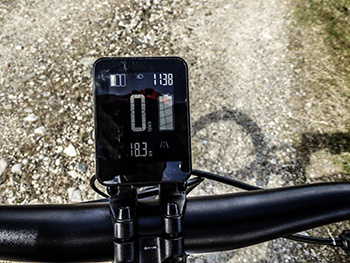
the default display shows the chosen power mode (there are three levels on offer, selected via a bar mounted switch), speed, remaining battery level, time of day and a switchable portion that provides trip distance/ride time/odometer, depending on rider choice. the country in which the vado is sold, decides on whether the motor support is either limited to a maximum of 25kph (pedelec), or 48kph (s-pedelec). in the uk, the former reigns. rather obviously, the bike can be ridden faster than 25kph, but from 26kph and above, the motor provides no assistance and you're on your own with that rather heavy (21kg) bike.

going for a ride
after a slight delay, pressing the on/off button on the fuselage lights up the handlebar mounted display, at which point the vado is ready and willing to go. by default, two of the three available levels of motor assistance are engaged at this point; decreasing to one, or increasing to three is achieved by pressing either the + or - buttons on the left-side control switchgear. as a honed, self-respecting athlete, i was less than keen to engage anything above level one, relying on the nine-speed rear cassette to take care of pesky gradients.
however, it would be remiss of me in my position as reviewer to have avoided the two greater levels of support, so rest-assured, purely in the interests of scientific research, i tried the lot.
depending on your more regular style of riding, you might well find, as i did, that you exceed the maximum speed of motor support and end up riding faster than the limiter. this gives the effect of an independent braking system, holding you back with an unseen hand. in essence, so doing rather defeats the point of riding an electrically powered bicycle in the first place, becoming ultimately responsible for powering a heavy bicycle without assistance. therefore, it takes but a few kilometres to gain the mindset akin to that of a passenger, growing quickly accustomed to riding at 25kph no matter whether tail wind assisted or headwind hindered.

in fact, that last statement is somewhat vacuous, for even when faced with a galeforce wind, it remains possible to continue unabated at 25kph, either by increasing the level of motor support, or simply pressing a tad harder on the pedals. the rapid-fire, nine-speed gear comes in remarkably handy as the terrain varies, though changing up the block was pretty fierce on occasion. of course, increasing the motor support drains the battery more quickly, a fact in itself that alters your behaviour as a cyclist.
the bar mounted display shows the graphic equivalent of an aa battery, split into five discrete levels. once the first level has been used up, i immediately became the e-bike equivalent of a clock-watcher, overly concerned that the second level would disappear before i wanted it to. when the third level disappears from view, all of the remaining bike ride is absorbed with mental calculations as to whether home could be reached before i was running on empty. for your information (admit it, you were wondering when i'd get round to it), at level one motor support, i reckoned to get around 15km per battery level, offering an effective range of 75km out and back. increasing the motor support tautologically reduces the bicycle's range.

throughout the review period, i only ever depleted the battery to the point where two levels remained. however, restoring the charge took approximately five hours which, i must confess, was a bit longer than i'd expected.
the need for a key to remove the battery seems a sensible precaution, allaying fears that you might return to a batteryless bike if parked in town. however, i can't help thinking that specialized missed a trick by not having the key enable/disable the electrics entirely. thus, it would be necessary to insert and turn the key to enable the motor; taking the bicycle without a key would restrict any chance of a quick getaway. this might not prevent theft of an expensive bicycle, but it would surely throw another hurdle in the direction of a would-be thief?
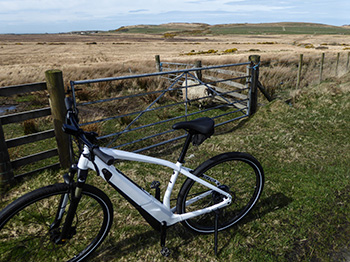
at one point during my reviewing schedule, i had need of undertaking a morning ride of 10km for a meeting. had i ridden my specialized 'cross bike - the more usual non e-bike choice - i fear i would have been a touch more perspirational on arrival than desired. riding the vado meant that i arrived, not only punctually, but as cool as the proverbial cucumber. used for its specified purpose as an urban e-bike, this facet of electric riding might well pay great dividends in a close-captioned office environment where the only heat might transpire from a charging battery.
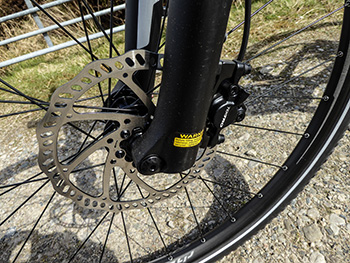
assuming either my calculations to be accurate or when closely proximitous to base, i occasionally switched the motor support up to level three at the foot of any untoward gradient. at such a point, the vado almost rode up the hill on its own and i tend to think this is the most sensible strategy to employ when riding to work, school or the shops. when the road's flat: level one. when the road slides minimally upwards: level two. when there's a real hill: level three. just remember to switch down to a more appropriate support level whenever possible to not only save the battery, but simultaneously indulge in a modest degree of exercise.
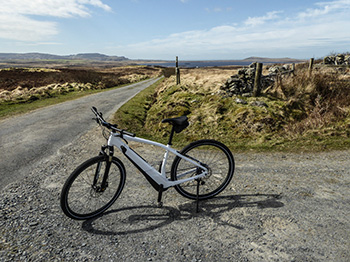
after all, that's what cycling's really all about.
i'm not a fan of flat bars; i never have been. however, currently specialized do not offer an e-bike with drop bars (are you listening mr sinyard?), and it's possible that the average commuter is more comfortable with flat in any case. however, i cannot believe that mr average cycle commuter would be any happier with 68 centimetres of width than was i. there's a small gap in the wall leading to the washingmachinepost bikeshed and prior to riding through said gap, i always switched off the motor to allow unaided navigation via handlebars that were but a few centimetres narrower. navigating rush hour traffic would surely be an easier task with narrower bars?

if this were my bike, i'd cut the bars down.
part of my disdain for flat bars revolves around the upright riding position engendered by such. though i doubt there are such severe headwinds in an urban setting, bolt upright is not the way to scrabble along uiskentuie strand in a stiff breeze. aside from which, sitting upright placed more weight on my posterior and the canopy saddle, centre slot notwithstanding, is not the most comfortable upon which i have ever placed my butt. however, the sturdy 47mm rubber fitted front and rear, ameliorated the sting in the tail to an impressive degree and certainly helped me float over the hundreds of potholes encountered over the course of a day.
in this, they were aided and abetted by those suspension forks on which i'd originally locked out the bounce, as any self-respecting roadie would. however, given the nature of the beast, i opted into the spring after only a few days; after all, it's a heavy bike. if you're going to spend more than £2,000, on a bicycle, it doesn't seem too wrong to use every potential advantage it provides.

the substantial frame of the vado displays none of the ride properties to be found in such as a specialized crux, roubaix or venge, but then that's hardly the point. designed as a means of urban transport, it manages precisely what it says on the tin and does so remarkably well. however, given the difficulty of lifting it in and out of the bikeshed, you'd need either to live on the ground floor, or have somewhere to safely park it at street level. it would be naive to encapsulate the e-bike as the sole vision of the future, but it's definitely one particularly successful vision that offered a bit more fun than i'm currently willing to admit to.
monday 4 june 2018
 ..........................................................................................................................................................................................................
..........................................................................................................................................................................................................